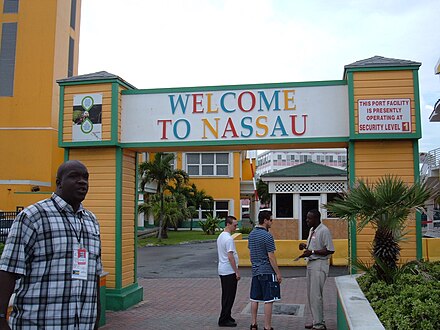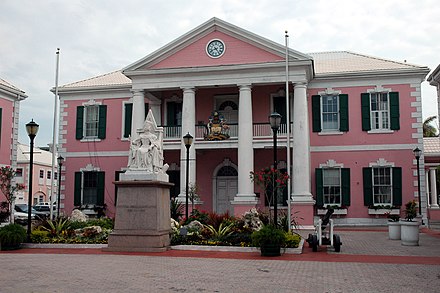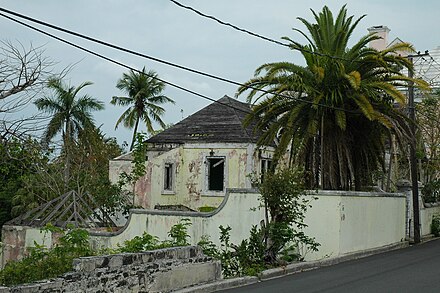Nassau - capital city of the Commonwealth of the Bahamas
For other places with the same name, see Nassau (disambiguation).
Nassau is the capital of The Bahamas. It is the largest city in the Bahamas and its low-rise sprawl dominates the eastern half of New Providence Island. The city's name is locally pronounced like "NAH-sor" but without the R.
Understand
Founded around 1650 by the British as Charles Town, the town was renamed in 1695 to honor the ruling house in the Netherlands (and later England), which ultimately derives from Nassau Castle, Rhineland Palatinate. Due to the Bahamas' strategic location near trade routes and its multitude of islands, Nassau soon became a popular pirates' den, and British rule was soon challenged by the self-proclaimed "Privateers Republic" under the leadership of the infamous Edward Teach, better known as Blackbeard. However, the alarmed British soon tightened their grip, and by 1720 the pirates had been killed, switched to more legitimate businesses or driven out.
Nassau grew immensely after the end of the American War of Independence as many loyalists (and their slaves) who did not move to Canada settled here. Later free Blacks - including those freed from illegal slave ships by the British Navy - settled here.
Nassau would again profit from events in the US during the American Civil War when blockade runners made a small fortune. US policy would again inadvertently benefit Nassau when it became a party destination for those who could afford it during prohibition. The Bahamas in general and Nassau in particular were one of the first destinations for the international "jet-set" of people rich enough and blessed with enough free time to take - then prohibitively expensive - jet aircraft to party locations around the globe. The Cuban Revolution of 1959 further benefited the local tourism industry as the new regime was a lot less lenient towards gambling Americans and the mob or other North American "bourgeoisie" owning everything worth owning in Havana. To say nothing of the US imposed restrictions on their own citizens visiting Cuba. Today Nassau has both become more accessible to people of more modest means and less exclusive due to it, but its close location to the US as well as its economic political and cultural ties to the US and the Commonwealth still make it a common tourist destination.
Today, with a population of 274,400 (2016), Nassau contains nearly 80% of the population of the Bahamas. However, it's still quite low-rise and laid back, with the pretty pastel pink government buildings and the looming giant cruise ships that dock daily.
Climate
Located slightly north of the tropics, Nassau has a tropical monsoon climate with considerable differences throughout the year in amounts of rain and rainy days. December to April are the driest months with 6-8 rainy days per month, whereas the rainiest time of the year corresponds to the Northern Hemisphere summer months. Temperatures are warm throughout the year.
Orientation
Orienting yourself in central Nassau is fairly easy. Bay Street, which runs parallel to the shore, is the main shopping street, filled with an odd mix of expensive jewelry boutiques and souvenir shops. The hill that rises behind Bay St contains most of the Bahamas' government buildings and company headquarters, while the residential Over-the-Hill district starts on the other side.
Get in
By plane
Nassau's Lynden Pindling International Airport 📍 (IATA: NAS) is the largest airport in the Bahamas. Most major U.S. airlines have flights to Nassau. There is also some service from Toronto and London.
The two most popular Fixed Based Operators (FBO) at Lynden Pindling International Airport are Executive Flight Services and Odyssey Aviation. Air taxi and air charter companies such as Jetset Charter and Monarch Air Group fly a variety of private charter aircraft and jets, from charter luxury Gulfstream's down to economical piston twins for small groups and individuals into and out of Nassau.
The airport has seen better days, but the free drinks occasionally served on arrival and the live band serenading the Immigration hall help set the tone. There's a list of fixed taxi fares posted at the exit. It's about US$27 and 10 mi (16 km) to most hotels in central Nassau. No public transportation goes into the airport, but if you really want to take the bus, you need to walk out of the airport onto the main road (John F Kennedy Dr). Cross the road to catch the bus 12B that goes into the city center. There is no bus stop so just wait by the roadside and wave it down when it comes. Runs about every 30 min. Fare is $2.50.
For departures, there are three terminal concourses: domestic and charter flights, flights to the US, and non-US international flights. US Immigration/Customs preclearance can be very time-consuming, so show up at least two hours before your flight. Security for other destinations is considerably more laid back, and an hour should suffice.
By sea
Nassau is a favorite port of call for the many cruise ships plying the Bahamas. Up to seven cruise ships can dock at the Prince George Wharf Cruise Terminal adjacent to downtown Nassau. For island-hopping within in The Bahamas, a good option would be Bahamas Ferries, which has several sailings each week to Nassau from most other islands.
Get around
By water taxi
A water taxi service is an available alternative to a taxi to get to Paradise Island from downtown. It is picked up under the bridge and costs $6 round trip. The water taxi stops operating at 6PM.
By minibus
Minibuses (locally known as jitneys) act as the bus system of Nassau city and New Providence island. Jitneys are found on and near Bay Street. The famous #10 Jitney to Cable Beach loads passengers on George & Bay Streets (in front of McDonalds, across from the British Colonial Hilton). Other jitneys are located on Charlotte & Bay Streets. A bus will typically wait until it's full before departing. Understanding the various routes can be complex. Many have destinations painted on the bus, but there is no standard as they are run by multiple companies and individuals. Ask around for your destination. Note that there is no jitney that goes to Paradise Island (Atlantis Resort).
Journeys cost $1.25 per person, per ride. A round trip, even if not getting off the bus (ie: sightseeing), is counted as two rides. Payment is received by the driver when disembarking. No change is given, and there is no transfer credit for changing busses.
The jitney is definitely a very inexpensive way to enjoy the local culture. Be aware that the jitneys stop operating between 6 and 7PM. The only way back to downtown after 7PM is by taxi which can be quite expensive.
The buses (also called jitneys) are 32-seaters and travel to many parts of the Island. They operate from 6:30AM to 6PM daily, except on Sundays when there is limited service. The basic fare is $1 per person and $2 for areas on the outskirts of town. Exact fare is required. The schedule is as follows:
From Bay Street (opposite Parliament Street) to the Eastern end of the Island (including foot of the bridge to Paradise Island) and return -- Bus Numbers: 1, 9, 9A, 9B, 19, 21, 21A, 23
From Bay Street (opposite Market Street) to the Marathon Mall and return -- Bus Numbers: 1, 1A, 3, 19, 21
From Frederick Street (Bay Street) to Town Center Mall and return -- Bus Numbers: 4, 4A, 5, 5A, 6, 6A, 11A, 12, 15, 15A
From Bay Street (George Street) to Cable Beach and return -- Bus Numbers: 10, 10A
By taxi
Taxis, often minivans and always identifiable by their yellow license plates and little Gothic blackletter "Taxi" lettering, roam the streets of Nassau. They're equipped with meters but will usually refuse to use them, so agree on the fare in advance. A short ride from the airport to Cable beach costs $18, to downtown is $26. Expect to pay $15-20 for even the shortest of trips from downtown to Cable Beach. They cost $4 (per person, $11 minimum) from Paradise Island to Downtown.
By car
You could also rent a car. All major U.S car rental shops are in Nassau. Worthy of note for travelers from the UK is the very British feel of the roads. Bahamian roads are left-hand drive, have UK road signs, and the odd roundabout.
By scooter
Scooter (small motorcycle) rental is also popular in Nassau.
By bike
Bicycle rental is not popular and not recommended as traffic is bad, there are many blind corners in the old streets of Nassau, and cars drive recklessly and on the left side of the road, which you may not be used to.
By foot
Within downtown Nassau, you could walk around. Distances are very short and a walking tour is a pleasant way of exploring downtown Nassau.
See
- Take a walk around Old Town, an interesting mixture of abandoned buildings and bright Caribbean structures. It doesn't take long to get away from the over-scrubbed tourist areas in the very center. Walk ten minutes uphill to the pink Parliament House 📍, which has a statue of an enthroned Queen Victoria out front.
- Ardastra Gardens, Zoo & Conservation Center, 25.0759°, -77.3617°, +1 242-323-5806, info@ardastra.com. 9AM-5PM. Visit the Bahamas' only zoo. See the marching flamingo shows. Let the parakeets land on you as you feed them. $15
- National Art Gallery of the Bahamas, West & West Hill Streets, 25.0754°, -77.3473°, +1 242-328-5800. Tu-Sa 10AM-4PM. Opened in 2003, this showcases Bahamian art from the precolonial era to the present. The quality of art is rather uneven to say the least, but the renovated building — once the residence of the Chief Justice — is a sight in itself. Adults $5, students/seniors $3
- Pirates of Nassau Museum, George St, 25.077391°, -77.34458°, +1 242-356-3759, piratesofnassau@batelnet.bs. M-Sa 9AM-6PM, Su 9AM-noon. Recreations of a pirate town, a pirate ship and a pirate battle, with a few real artifacts mixed in. Cheesy, but fun. Try to catch a guided tour. $12
- Fort Fincastle, Bennet's Hill, Prison Lane, 25.073611°, -77.338611°, +1 242-356-9085, pompey33@hotmail.com. A small fort built in 1793 which overlooks the city of Nassau from a small hill south of town. Several cannons are on display. Tours are conducted daily 8AM-3PM.
- James Bond wrecks.
- Cable Beach, 25.073611°, -77.406667°.
Do
The bus tours are pretty interesting. They'll drive you around, and tell you about the local government, tell you about different points of interest, and take you to old forts, and to Paradise Island, to see the famous Atlantis hotel resort and its stunning aquarium.
- Queen's Staircase, 25.073837°, -77.337818°. 66-step staircase named after Queen Victoria. 2017-11-13
Buy
- Straw Market, Bay St. Originally a locals' market, this is now devoted to touristy bric-a-brac. If you are in the market for some souvenirs, this is the place to come. Don't be discouraged by the initial price of things, as this is the only place you can haggle for a better one. Americans don't have to worry about exchanging any money either, as US currency is accepted universally.
- Potters' Cay, under the Paradise Island bridge. Best known for its fish market, and there are plenty of stalls that prepare fresh conch salad, conch fritters and other Bahamian seafood delicacies, but there's plenty of other exotic tropical produce available too.
Eat
Get out of the hotel and try real Bahamian fare. You can get greasy fish, sides and desserts at one of the holes-in-the-wall in downtown Nassau for around $8. On the upscale side, there's no shortage of waterside seafood restaurants where it would be easy to part with $50 for an excellent piece of lobster. Sbarro, McDonald's and Chinese restaurants are mixed in to satisfy the budget diner or someone who has had enough conch.
Mid-range
- The Shoal Restaurant and Lounge, Nassau Street, +1 242 323-4200. Sa-Th 7:30AM-11PM, F 7AM-7PM. If the tourist crowds are getting you down, take a taxi out to where the locals eat. Enjoy fish that falls off the bone, friendly service, and a dessert of guava $10-20
Splurge
- Cafe Matisse, Bank Lane (behind Parliament Sq, off Bay St), 25.077146°, -77.340214°, +1 242-356-7012. Tu-Sa noon-11 PM. Tucked away on a quiet lane, Matisse serves excellent Italian food with fresh local ingredients. Reservations recommended; try to get a seat in the delightful garden courtyard, which is shady by day and lit up at night. "Proper" dress (no shorts or sandals) required for dinner. $50-70
Drink
Nassau isn't a spring break mecca for nothing. The club scene is nightly and rowdy. Some popular establishments:
- Señor Frogs, +1 242 323-1777. 11AM-3AM. Next to the cruise dock, beside a stinky sewer pipe. Check which way the wind is blowing before you order. Doesn't serve Kalik.
- Club Waterloo, East Bay Street. 8PM-4AM. On the north side of the island, about two miles from the dock.
- Cocktails and Dreams, West Bay Street, +1 242 328 3745. Draws a sketchier crowd, although it is on the beach. Come here in a group.
- Club Fluid. Draws a very local crowd. You will get lots of recommendations from Bahamians you meet, but it is not a tourist club at all.
Cover charges average $20, although all major hotels sell "passes" for $5. With a pass, cover charge is only $5, so you actually pay $10. Cover charges on weekends can climb up to $45, so it's a good idea to get a pass from your local taxi driver/hotel desk.
You can also opt for an all-inclusive entertainment pass, which will include a schedule. Expect to follow this itinerary with at least 5,000 other co-eds. (It might be a good idea to pick up this schedule even if you don't plan on participating. It will give you a good idea of places to avoid on certain nights.)
Drinks in clubs can get expensive, depending on the club and its location. Many locals "drink up" before going out, to defray this cost. Otherwise they may be found in the parking lots with a cooler. Expect to pay at least $4 for a beer and $5 for a cocktail. The one exception is rum, which is cheap and plentiful. Cocktails with rum at a club will be strong.
Sleep
Many of Nassau's hotels are located outside the city core on Paradise Island or Cable Beach.
- British Colonial Hilton Nassau, One Bay Street, 25.078176°, -77.345753°, +1 242 322-3301. A hotel catering more to business travelers than package tourists. Occupies the site of a historical landmark (Fort Nassau), and has its own private beach, from which you get a fantastic view of the cruise ships going into, going out of, and berthed at the docks. Step out of the hotel and you're right downtown on Bay Street's shopping attractions. 2016-11-27
- Graycliff Hotel, West Hill Street, 25.075764°, -77.345608°, +1 242-302-9150. 2016-11-27
- Towne Hote, George Street 40, 25.077051°, -77.344297°. A slightly cheaper, downtown hotel. 2016-11-27
- Sunrise Oceanfront Cottage (www.hostelworld.com), Eastern Point, Nassau, Bahamas (Eastern Road travelling East, pass Prince Charles Drive T-junction on your right, beach on the left, after the 3rd house on your left, turn left, straight ahead yellow cottage on the ocean), +1 242-324-0105. $50 person
- Grand Hyatt Baha Mar, One Baha Mar Boulevard, PO Box SP-64254, Nassau, The Bahamas (Located on Cable Beach), 25.069363°, -77.39914999999996°, +1 242 788 1234. This Nassau luxury resort includes the Baha Mar Casino, along with the sumptuous spa, ESPA Baha Mar. Grand Hyatt Baha Mar Resort in Nassau, Bahamas offers a luxury stay during your island getaway. 2017-10-19
Stay safe
The "Over-the-Hill" area south of downtown is the poorest part of Nassau, and tourists might want to be wary. It is, however, much nicer than "slums" in the Third World and, indeed, parts of the United States.
Some criminals target restaurants and nightclubs frequented by tourists. The most common approach is to offer victims a ride, either as a "personal favor" or by claiming to be a taxi, and then robbing and/or assaulting the passenger once in the car. Take care to ride only in licensed taxis, identifiable by their yellow license plates.
Be wary of touts offering goods and services. As in other tourist destinations, some people try to take advantage of visitors. Common ploys in Nassau are to try to convince you to join on jet-skiing or booze cruise excursions.
Locals may solicit tourists with offers of marijuana, hairbraiding services, or a taxi ride. It gets monotonous but a friendly "no, thank you" and moving on will keep both you and the local happy.
Most Cuban cigars for sale in Nassau are counterfeit. Buy only from reputable dedicated tobacconists. See warning on main Bahamas page.
There is a high crime rate in Nassau. US Dept of State has labelled New Providence "Critical" and Grand Bahama "High". Crime previously among drug-related groups has now moved toward armed robberies of tourists. Recent local news reports suggest this is not abating.
Cope
Embassies
- 🇬🇷 Greece, Olympia Building, West Bay Street, +1 242 323-3495.
- 🇺🇸 United States, Queen Street #19, +1 242-322-1181, embnas@state.gov.
Go next
- Paradise Island, just across a bridge from Nassau. It is home to the lavish Atlantis hotel and resort.
Nassau
nassauparadiseisland.comNew Providence
Primary administrative division



